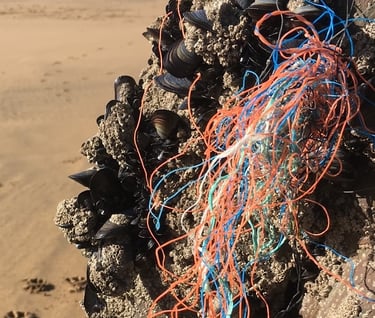Whilst you may consider John’s artistic creations to be beautiful, his art serves to underline the serious damage we are doing to our home through our yearning for ever more convenient and disposable lifestyles. All John’s art is made from plastic washed up on beaches in south-west England.
Plastic litter in the sea is the scourge of the modern world, much of it is there through irresponsible activities such as poor waste management practices (in the developed and developing world alike), spillages at sea, or through our own littering. Go to any beach in this country and you will find varying degrees of plastic waste. A report recently commissioned by the Marine Conservation Society and Natural England found that marine litter was particularly prevalent on beaches in Devon and Cornwall. But the plastic found on the beach is just the tip of the iceberg. Oceans cover 70% of the planet, and our plastic waste is found everywhere, floating on the surface, underwater, and on the seabed.
Plastic marine litter

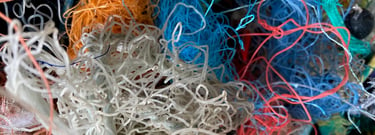
Some numbers.....
Since plastic went into mass production in the 1950’s, 8.3 billion tonnes (that’s 8,300,000,000) have been produced. Around 80% of this is estimated to be in landfill or the environment, with only 9% having been recycled.
Currently, 359 million tonnes of plastic are produced every year, and this is forecasted to increase to 600 million tonnes by 2050. The vast majority of plastics are made from oil, accounting for 4% of the world’s oil production.
Packaging, predominantly single use, accounts for 40% of all plastic produced.

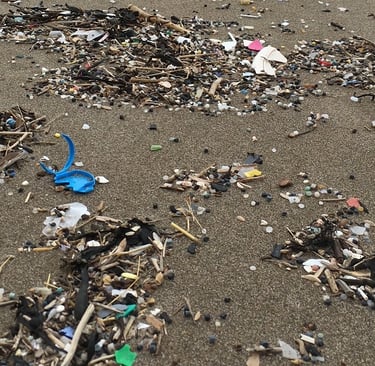
Around 70% of all litter in the oceans is made of plastic, and up to 12 million tonnes of plastic are thought to enter the ocean each year, globally. The quantity of plastic in the ocean was predicted in 2015, to triple by 2025.
Single use items together with rope and netting and sewage related debris are the most abundant types of plastic litter found in the marine environment. Whilst there are many larger pieces of plastic in the ocean, nano and micro plastics (NMPs) are of particular concern. These are fragments and particles less than 5mm in size.
NMPs can be produced at that size eg microbeads from the cosmetic sector, or pellets (nurdles) for the plastic manufacturing industry. NMPs are also formed from the fragmentation or degradation of larger plastic items often due to solar radiation and exposure to wind and waves, or for example from abrasion during laundry of synthetic textiles, and the abrasion of car tyres from driving.
Microplastics don’t just float, they have been found on the ocean floor, and inside marine organisms at various depths. Plastics also attract organic pollutants found in the water that can lead to bioaccumulation and transport up the food chain.
Plastic in the oceans
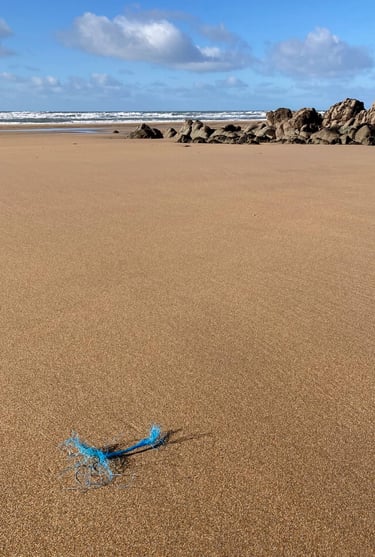

Impacts on wildlife
The EU recently concluded that plastic marine litter presents a “large scale and serious threat to the welfare of marine animals”
Impacts can include entanglement, often caused by encountering abandoned, lost or discarded fishing gear, and ingestion. When birds, fish and other marine organisms encounter plastic pollution it can result in severe physical harm and death, or have less obvious but equally harmful effects such as compromising an individual’s ability to feed, escape from predators or migrate.
There is research as well as anecdotal evidence that plastic is being ingested across a wide range of marine organisms. In a Scottish survey, 83% of Langoustines had plastic in their stomachs; in the Mediterranean, surveys showed that 96% of Cory’s shearwaters and 80% of Loggerhead turtles had plastic in their stomachs. Recent headline stories include the baby turtle that was found with 104 pieces of plastic in its body.
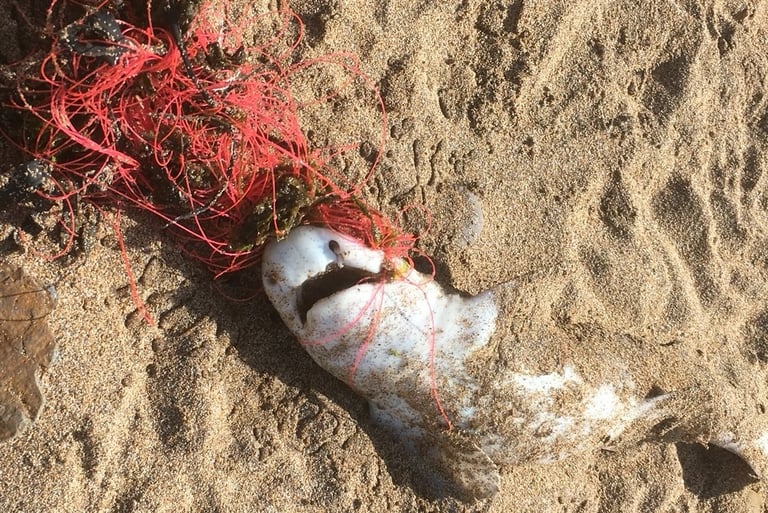

Impacts on the environment and human health
Plastic in the sea and on beaches reduces the amenity value of coastlines and necessitates costly ongoing clean-up operations. Whilst there is extensive voluntary beach cleaning, many local authorities carry out their own beach cleaning operations at an annual cost estimated at over £15 million. Beach litter is known to influence visitors choice of beaches to visit, and even small amounts of litter can diminish the restorative value of a visit to the coast.
Plastic pollution is hazardous to mariners especially those using small craft such as surfers and paddleboarders. It is also known to affect fishing operations and there are numerous cases of entanglement of rope and net around the propellors of larger craft.
Whilst there is currently a lack of evidence to show the full effect on humans, it is clear that plastic is being found in the food chain, and is being transferred into human organs. This is a major focus of current and proposed research.
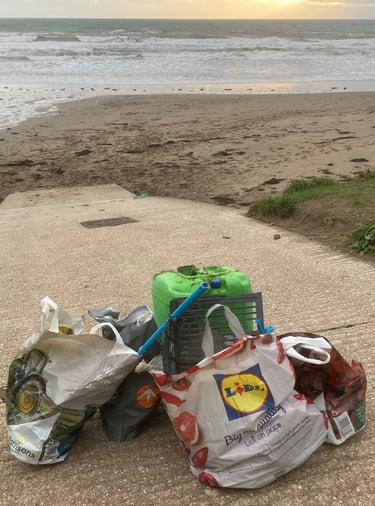

So, what can we do.....?
Plastic pollution is a big issue. Right now. 80% of the population think so. And it affects us here in the south-west - some of our favourite beaches are amongst the most polluted in the UK. And whilst we would all agree that plastic is a useful commodity, we must also acknowledge that it’s the way we manage it after use that causes the problem. It doesn’t have to be this way. So, what can we do?
There are many ways of getting involved:
Find out more about the issue. There are many resources out there: for example, seek out Plymouth University’s Marine Institute, and also in Plymouth, the Marine Biological Association.
Alter your own behaviour, eg look for alternatives to plastic, avoid single use packaging, re-use where possible, and be aware of what happens to your waste. And then tell your friends;
Organise or get involved in a beach clean or a litter pick. Even land-based litter clearance will help to prevent the rubbish getting into our waterways and onwards to the sea;
Join organisations such as Greenpeace, Friends of the Earth or Surfers Against Sewage, so that together we can lobby for change at Government and industry level. The whole economy needs to shift towards a more circular one where waste is minimised, products have long lives, and materials can be reused.

